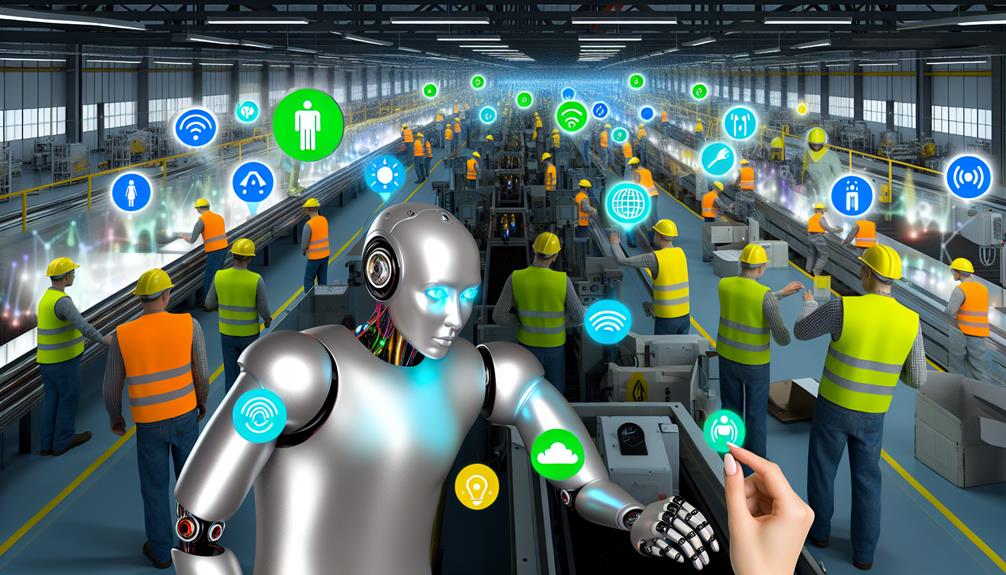In modern manufacturing, leveraging AI models has become essential for optimizing efficiency, reducing risks, and improving operational outcomes. Ten top AI models for manufacturing analytics include IBM Maximo for predictive maintenance, Siemens Insights Hub for supply chain optimization, SparkCognition Industrial AI Suite for proactive equipment failure detection, KUKA Industrial Robots for enhanced product quality, and Cognex In-Sight for advanced visual inspection. AI models like Oden Technologies Process AI and Rockwell Automation FactoryTalk Analytics optimize manufacturing processes. Plex enables secure data management, and ABB Ability offers extensive industrial analytics. Top AI platforms improve manufacturing efficiency and quality. Discover how these models revolutionize industry standards and explore their full potential.
Key Takeaways
- IBM Maximo: Uses cloud-based AI to optimize asset management and maintenance processes, reducing downtime and enhancing safety compliance.
- Siemens Insights Hub: Connects industrial IoT devices to digital tools for real-time operational data and predictive maintenance.
- ABB Ability: Provides industrial analytics and AI for unique insights into manufacturing, enhancing efficiency and productivity.
- SparkCognition Industrial AI Suite: Analyzes sensor data for predictive maintenance, reducing equipment downtime and increasing lifespan.
- Cognex In-Sight: Uses deep learning vision systems for automated quality control, detecting anomalies and defects in real-time.
Predictive Maintenance Through AI
In pursuit of enhancing manufacturing efficiency and reducing downtime, the strategic application of AI-driven predictive maintenance revolutionizes equipment management through advanced data analysis and anomaly detection.
By leveraging machine learning algorithms, predictive maintenance minimizes unplanned downtime, boosts productivity, and guarantees equipment reliability in manufacturing facilities. This innovative approach markedly reduces downtime by up to 30% and maintenance costs by 40%.
Real-time monitoring and anomaly detection enabled by AI prevent unexpected breakdowns and enhance production continuity.
AI-driven predictive maintenance improves equipment lifespan and operational efficiency by forecasting.
Intelligent Supply Chain Management
In the manufacturing sector, AI-driven technologies are transforming supply chain management. These technologies elevate demand forecasting and predictive inventory management to unparalleled levels of accuracy. By leveraging advanced analytics tools, businesses can better anticipate and adapt to shifting consumer patterns. This helps minimize stockouts and overstocking, thereby reducing operational costs.
Efficient supply chain operations enabled by AI not only enhance customer satisfaction but also contribute greatly to a company's overall profitability.
Demand Forecasting Tools
Manufacturers are utilizing advanced AI models in demand forecasting tools to accurately predict customer demand, optimize production schedules, and secure efficient supply chain management. By leveraging these tools, businesses can enhance their production processes and inventory management systems, ensuring that products are on the shelves when and where they are needed.
Key features of these tools include:
- Predictive Analytics: Advanced algorithms like ARIMA and machine learning models analyze historical data and market trends to predict future demand with high accuracy.
- Inventory Management: Real-time monitoring and adjustment of inventory levels prevent stockouts and overstocking, minimizing waste and reducing costs.
- Supply Chain Management: Quick responses to demand changes enable efficient allocation of resources and streamlined logistics.
- Flexibility: Tools can adapt to changing market conditions and customer behaviors, ensuring adaptability in the face of uncertainty.
These AI-driven tools are essential for manufacturers to maintain competitiveness in today's fast-paced market. By integrating advanced analytics and automation, businesses can raise customer satisfaction, reduce waste, and optimize their overall supply chain performance.
Predictive Inventory Management
Predictive inventory management leverages AI models to harness historical data and predictions to accurately forecast demand, guaranteeing best inventory levels and streamlined supply chains. The continuous evaluation of historical sales data and other external factors helps AI-powered inventory systems to adapt and improve their forecasting accuracy over time. This results in substantial benefits for manufacturing operations, such as:
```markdown
| Benefits | Description |
|---|---|
| Cost Savings | AI models reduce excess inventory, minimizing carrying costs. |
| Improved Efficiency | Predictive analytics optimize production scheduling and resource allocation. |
| Better Customer Satisfaction | Accurate forecasting guarantees the right products are in stock when needed, leading to increased customer satisfaction. |
```
Demand Forecasting Strategies

To improve manufacturing efficiency, AI models are leveraged to fine-tune demand forecasting strategies.
By mastering data modeling techniques and harnessing predictive maintenance tools, companies can accurately anticipate and adapt to market fluctuations.
This guarantees ideal inventory levels, minimizing stockouts and overstocking.
Data Modeling Techniques
Accurate demand forecasting is an essential component of effective production planning and inventory management in manufacturing, which can be achieved using data modeling techniques like time series regression models. These models analyze historical order data to predict future customer demand accurately, helping manufacturers optimize production schedules by anticipating fluctuations in demand.
Dynamics 365 Business Central supports the implementation and integration of these models for demand forecasting.
Key aspects of data modeling techniques for demand forecasting include:
- Time Series Regression Models: Analyze historical data to predict future demand.
- Integration with Business Processes: Integrate predictions into production planning and inventory management for seamless operations.
- Support for Enterprise Systems: Dynamics 365 Business Central supports the implementation of these models.
- Optimized Production Planning: Models help adjust production schedules to meet anticipated demand.
These data modeling techniques play an integral role in ensuring efficient production and inventory management.
Predictive Maintenance Tools
Manufacturers leveraged AI-powered predictive maintenance tools to overhaul traditional reactive maintenance practices. These tools utilize AI algorithms to analyze equipment data and predict failures before they occur, optimizing maintenance schedules and minimizing downtime. This proactive approach extends equipment lifespan, saving costs for manufacturers and improving overall operational reliability.
Predictive Maintenance Benefits
| Benefits | Description | Impact |
|---|---|---|
| Reduced Downtime | Predictive maintenance allows for scheduled downtime, reducing the unexpected loss of production time. | Increased Production Efficiency |
| Extended Equipment Lifespan | By addressing minor issues before they escalate, predictive maintenance extends the lifespan of valuable equipment. | Reduced Maintenance Costs |
| Proactive Maintenance | AI-powered predictive maintenance shifts the focus from reactive to proactive maintenance, ensuring continuous production and maximizing equipment effectiveness. | Enhanced Operational Reliability |
Quality Control and Assurances
What specific opportunities does integrating advanced computer vision and AI technologies offer to transform quality control processes in manufacturing environments?
AI models in quality control enable accurate and efficient identification of defects and anomalies on production lines. These models analyze visual data, allowing for real-time detection and alert systems to guarantee prompt action on quality issues.
- Enhanced Precision: AI-powered computer vision models are notably more precise in detecting anomalies than traditional manual inspections.
- Streamlined Quality Control: Automated detection systems reduce inspection time and minimize the need for human intervention.
- Proactive Maintenance: Early detection of anomalies allows for swift corrective action, reducing downtime and production losses.
- Improved Compliance: AI models can guarantee consistent quality control processes, ensuring regulatory compliance and maintaining high standards.
Integrating AI models into quality control processes can significantly enhance the efficiency and reliability of manufacturing operations.
Workforce Health and Safety Analytics

Best AI Models for Manufacturing Analytics – Workforce Health and Safety Analytics
By leveraging advanced computer vision and AI analytics to monitor workforce behaviors and compliance with safety protocols, manufacturing organizations can enhance their health and safety standards. This technology identifies risky body movements near machinery and alerts supervisors for proactive safety measures. Evaluating adherence to standard operating procedures, AI analytics aim to improve worker training and reduce accidents. AI's impact in manufacturing also boosts productivity, quality, and overall worker well-being.
Benefits of AI in Workforce Health and Safety Analytics
| Benefits | Description |
|---|---|
| Enhanced Worker Safety | Identifies risky movements, alerts supervisors for proactive measures. |
| Improved Productivity | Optimizes workflow, reduces downtime due to accidents. |
| Quality Control | Ensures adherence to standard operating procedures for better outputs. |
| Worker Well-being | Enhances overall health and well-being, reducing fatigue and stress.
Asset Performance Optimization
By integrating advanced AI models into their infrastructure, organizations can revolutionize their asset management strategies through optimized maintenance schedules and proactive equipment monitoring for enhanced operational effectiveness.
Enhancing Operational Effectiveness with AI Models
- Predictive Maintenance: AI models analyze equipment data to predict failures and optimize maintenance schedules.
- Proactive Monitoring: AI-driven predictive analytics enables companies to proactively monitor and predict equipment failures.
- Streamlined Operations: Implementing AI models helps streamline operations, reduce costs, and enhance productivity.
- Improved Efficiency: AI models optimize equipment effectiveness and minimize downtime, leading to notable enhancements in operational effectiveness and maintenance practices.
AI-powered asset performance optimization leverages machine learning algorithms and real-time data to guarantee the highest levels of equipment reliability.
Materials Management

Optimization of materials management processes through machine learning algorithms greatly enhances the efficiency and responsiveness of manufacturing operations. AI models in materials management play a pivotal role by optimizing inventory levels based on demand fluctuations and historical data.
These models analyze supply chain data to guarantee uninterrupted and efficient production by forecasting material requirements. Predictive analytics in materials management enhance cost savings and operational effectiveness in manufacturing processes by identifying potential material shortages or excesses and enabling proactive planning.
Employing AI models in materials management markedly minimizes storage costs and guarantees timely availability of raw materials. This results in improved production efficiency and faster response to changes in demand. By leveraging advanced analytical capabilities, AI models help to streamline procurement, storage, and distribution processes, ensuring that materials are available when needed.
Effective materials management drives operational excellence and boosts overall competitiveness in manufacturing.
Energy Efficiency Enhancement
State-of-the-art manufacturing facilities are leveraging artificial intelligence to revolutionize energy efficiency by uncovering hidden opportunities for cost savings and environmental sustainability. AI models in manufacturing analytics have proven to be highly effective in enhancing energy efficiency by optimizing equipment usage and reducing energy consumption. These models can analyze energy data in real-time to identify inefficiencies and recommend improvements for cost savings.
Key benefits of AI models in energy efficiency enhancement include:
- Predictive Analytics: Forecasting energy usage patterns to suggest proactive measures to minimize energy waste.
- Real-time Monitoring: Identifying inefficiencies in energy usage and providing recommendations for improvement.
- Cost Savings: Reducing operational costs through optimized energy consumption.
- Environmental Impact: Contributing to a more sustainable manufacturing process.
Real-time Inventory Control

In real-time inventory control, AI models equipped with predictive analytics skillfully optimize stock levels to mitigate stockouts and excess inventory challenges. This approach guarantees accurate inventory management by analyzing historical data and market trends in parallel, resulting in enhanced operational efficiency and cost savings.
Effective optimization of inventory levels also streamlines production processes in manufacturing, allowing for more agile and responsive operations.
Inventory Forecasting
Inventory Prediction
Manufacturers leveraging AI models in real-time inventory control can greatly enhance supply chain efficiency by guaranteeing best stock levels tailored to market demands and historical patterns. This strategic approach focuses on accurately predicting inventory levels and adjusting production to meet shifting customer requirements.
Key Benefits
- Precise Demand Forecasting: ARIMA models analyze historical data and market trends to generate exact predictions of inventory needs.
- Optimal Stock Levels: AI-driven algorithms guarantee the right amount of inventory is on hand to meet customer demand, reducing both overstock and understock scenarios.
- Supply Chain Efficiency: Automated inventory forecasting streamlines the supply chain by minimizing inventory-related delays and costs.
- Cost Savings: Exact forecasting helps manufacturers avoid overstorage costs and optimize production, leading to significant inventory cost savings.
Optimized Stock Levels
Accessing Effective Inventory Management:
AI-driven models assure best-suited stock levels in real-time by leveraging historical data and market trends to adjust production schedules, reduce costs, and enhance customer satisfaction.
Through advanced demand forecasting techniques, these models accurately predict demand fluctuations, allowing manufacturing companies to maintain ideal inventory levels.
This real-time inventory control minimizes the risk of overstocking or understocking, thereby improving customer satisfaction and revenue.
Production Planning
Intelligent manufacturing analytics systems leverage AI models to streamline real-time inventory control within production planning processes, guaranteeing that manufacturers maintain the finest stock levels at all times.
Predictive analytics enable proactive demand forecasting, allowing for timely adjustments to production schedules and inventory management. This real-time monitoring and adaptation guarantee ideal inventory levels, reducing the risk of stockouts or overstocking.
Key Benefits of AI in Manufacturing Production Planning:
- Improved Demand Forecasting: AI models accurately analyze historical data and current trends to predict demand fluctuations, enabling proactive production planning.
- Enhanced Inventory Control: Real-time monitoring and adjustment optimize inventory levels, minimizing excess costs and guaranteeing on-time delivery.
- Efficient Supply Chain Management: AI-driven insights optimize inventory replenishment and distribution, reducing logistical inefficiencies.
- Optimal Production Scheduling: AI analytics guarantee resources are allocated efficiently to meet demand, maximizing productivity and minimizing downtime.
Proactive Safety Insight Systems
Proactive Safety Insight Systems
Advanced computer vision and machine learning algorithms empower proactive safety insight systems in manufacturing to detect risky behaviors and potential hazards in real-time, allowing for swift interventions to protect workers and improve compliance with standard operating procedures. These systems utilize AI-driven analytics to monitor worker actions, particularly around heavy machinery and dangerous equipment. By evaluating body movements, these systems can identify high-risk situations and alert supervisors immediately, thereby preventing accidents and ensuring prompt medical assistance if needed. Additionally, they assess adherence to standard operating procedures (SOPs) and offer customized training to enhance overall safety standards.
In manufacturing environments, proactive safety insight systems greatly enhance the quality, productivity, and safety of operations. They are integrated with computer vision and machine learning to analyze data from various sources, enhancing the ability to predict and mitigate risks. This proactive approach guarantees a safer working environment, reduces incident costs, and minimizes downtime for equipment maintenance.
With such advanced systems, manufacturing facilities can enhance the well-being of their workers and optimize operational efficiency.
Frequently Asked Questions
What AI Is Used in Manufacturing?
AI technologies used in manufacturing include predictive maintenance to minimize downtime, quality control via computer vision and machine learning, and production optimization through advanced analytics and smart systems, enhancing overall efficiency to a great extent.
Which AI Tool Is Best for Data Analysis?
DataRobot stands out as the top AI tool for data analysis in manufacturing, excelling in predictive maintenance, supply chain optimization, production forecasting, and process optimization, ensuring seamless integration and peak performance.
How Generative AI Is Used in Manufacturing?
In manufacturing, generative AI is used for AI-driven design optimization by iteratively refining designs and creating diverse alternatives. It also enhances predictive maintenance by generating synthetic data and supports quality control automation by optimizing manufacturing processes.
What Are the 3 Fields of AI That Are Linked With Big Data Analytics?
Machine learning applications, deep learning techniques, and natural language processing algorithms are the three fields of AI closely linked with big data analytics. These technologies help manufacturers analyze vast data, make predictions, and improve decision-making processes.









